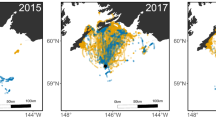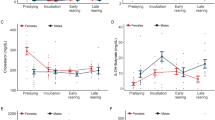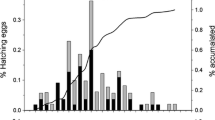Abstract
Seabird parents during chick rearing is hypothesized to regulate body mass to reduce flight costs and invest energy in current reproduction. Alcids have 2‒4 times higher wing-loading and higher flight costs than other seabirds. In particular, rhinoceros auklets Cerorhinca monocerata (RHAU) carry the heaviest meals among alcids despite its medium-size, therefore, we expected that they might be more likely to keep their body mass small and within a narrow range during chick rearing. We examined between-breeding stage and interannual variations in RHAU body mass using 27-year monitoring data, then tested whether the interannual variation shown by the coefficient of variation (CV) in body mass during chick rearing was smaller than in other seabirds, and if their body lipid stores were smaller. RHAU during chick rearing have 15‒20 g lower body mass, corresponding to 5‒7% decrease of flight costs, than those during incubation. We found that CV of body mass in RHAU (1.4) was smaller than those of 10 other seabird species (1.7‒7.5), while CVs in provisioning metrics, such as meal mass, chick growth, fledgling mass, and fledging success, were the largest or second largest. RHAU body lipid stores during chick rearing (3.8‒4.0%) was also smaller than six other species (5.7‒9.5%). Results suggest that chick-rearing RHAU maintained a narrow range of body mass with minimum body lipid stores, possibly because of their greater wing-loading and heavier meals. Such constraints on body mass regulation might affect their variable investment in their chicks under environmental variability, as shown large variation in provisioning metrics.




Similar content being viewed by others
Data availability
The results of our analyses are presented as the main tables and figures. We have also included the data for mean provisioning metrics or body mass for each species used in this study as supplementary information. The raw data for rhinoceros auklets will be made available upon request.
References
Baillie SM (2001) Atlantic Puffin response to changes in capelin abundance in Newfoundland and Labrador: an inter-colony and inter-decade comparison. Master’s thesis, Memorial University of Newfoundland
Baillie SM, Jones IL (2004) Response of Atlantic Puffins to a decline in capelin abundance at the Gannet Islands, Labrador. Waterbirds 27:102–111. https://doi.org/10.1675/1524-4695(2004)027[0102:ROAPTA]2.0.CO;2
Bates D, Maechler M, Bolker B, Walker S (2015) Fitting linear mixed-effects models using lme4. J Stat Softw 67:1–48. https://doi.org/10.18637/jss.v067.i01
Biodiversity Center of Japan (2017) Monitoring site 1000 seabird investigation report fiscal year 2016. Nature Conservation Bureau, Ministry of the Environment, Fujiyoshida, Japan (in Japanese with English abstract).
Borstad G, Crawford W, Hipfner JM, Thomson R, Hyatt K (2011) Environmental control of the breeding success of rhinoceros auklets at Triangle Island, British Columbia. Mar Ecol Prog Ser 424:285–302. https://doi.org/10.3354/meps08950
Büßer C, Kahles A, Quillfeldt P (2004) Breeding success and chick provisioning in Wilson’s storm-petrels Oceanites oceanicus over seven years: frequent failures due to food shortage and entombment. Polar Biol 27:613–622. https://doi.org/10.1007/s00300-004-0627-z
Cairns DK (1987) Seabirds as indicators of marine food supplies. Biol Oceanogr 5:261–271. https://doi.org/10.1080/01965581.1987.10749517
Chappell MA, Janes DN, Shoemaker VH, Bucher TL, Maloney SK (1993) Reproductive effort in Adélie penguins. Behav Ecol Sociobiol 33:173–182. https://doi.org/10.1007/BF00216598
Chavez FP, Ryan J, Lluch-Cota SE, Ñiquen CM (2003) From anchovies to sardines and back: multidecadal change in the Pacific Ocean. Science 299:217–221. https://doi.org/10.1126/science.1075880
Cherel Y, Robin J-P, Le MY (1988) Physiology and biochemistry of long-term fasting in birds. Can J Zool 66:159–166. https://doi.org/10.1139/z88-022
Clutton-Brock TH (1991) The evolution of parental care. Princeton University Press, Princeton
Cohen LA, Pichegru L, Grémillet D, Coetzee J, Upfold L, Ryan PG (2014) Changes in prey availability impact the foraging behaviour and fitness of Cape gannets over a decade. Mar Ecol Prog Ser 505:281–293. https://doi.org/10.3354/meps10762
Cubaynes S, Doherty PF, Schreiber EA, Gimenez O (2011) To breed or not to breed: A seabird’s response to extreme climatic events. Biol Lett 7:303–306. https://doi.org/10.1098/rsbl.2010.0778
Deguchi T, Watanuki Y, Niizuma Y, Nakata A (2004) Interannual variations of the occurrence of epipelagic fish in the diets of the seabirds breeding on Teuri Island, northern Hokkaido, Japan. Progr Oceanogr 61:267–275. https://doi.org/10.1016/j.pocean.2004.06.010
Deguchi T, Wada A, Watanuki Y, Osa Y (2010) Seasonal changes of the at-sea distribution and food provisioning in rhinoceros auklets. Ecol Res 25:123–137. https://doi.org/10.1007/s11284-009-0639-9
Elliott KH, Ricklefs RE, Gaston AJ, Hatch SA, Speakman JR, Davoren GK (2013) High flight costs, but low dive costs, in auks support the biomechanical hypothesis for flightlessness in penguins. Proc Natl Acad Sci U S A 110:9380–9384. https://doi.org/10.1073/pnas.1304838110
Fraser G, Jones IL, Williams C, Hunter FM, Scharf L, Drive B (1999) Breeding biology of Crested Auklets at Buldir and Kasatochi Islands, Alaska. Auk 116:690–701. https://doi.org/10.2307/4089330
Gaston AJ, Hipfner JM (2006a) Adult Brünnich’s Guillemots Uria lomvia balance body condition and investment in chick growth. Ibis 148:106–113. https://doi.org/10.1111/j.1474-919X.2006.00489.x
Gaston AJ, Hipfner JM (2006b) Body mass changes in Brunnich’s guillemots Uria lomvia with age and breeding stage. J Avian Biol 37:101–109. https://doi.org/10.1111/j.2006.0908-8857.03426.x
Gaston AJ, Jones IL (1998) The auks: alcidae. Oxford University Press, Oxford
Groscolas R, Decrock F, Thil M, Fayolle C, Boissery C, Robin J-P (2000) Refeeding signal in fasting-incubating king penguins: changes in behavior and egg temperature. Am J Physiol Regulatory Integrative Comp Physiol 279:2104–2112. https://doi.org/10.1152/ajpregu.2000.279.6.R2104
Groscolas R, Lacroix A, Robin JP (2008) Spontaneous egg or chick abandonment in energy-depleted king penguins: A role for corticosterone and prolactin? Horm Behav 53:51–60. https://doi.org/10.1016/j.yhbeh.2007.08.010
Harding AMA, Welcker J, Steen H, Hamer KC, Kitaysky AS, Fort J, Talbot SL, Cornick LA, Karnovsky NJ, Gabrielsen GW, Grémillet D (2011) Adverse foraging conditions may impact body mass and survival of a high Arctic seabird. Oecologia 167:49–59. https://doi.org/10.1007/s00442-011-1971-7
Harris MP (1979) Measurements and weights of British Puffins. Bird Study. https://doi.org/10.1080/00063657909476636
Harris MP, Wanless S (2011) The Puffin. Yale University Press, New Haven and London
Hedd A, Bertram DF, Ryder JL, Jones IL (2006) Effects of interdecadal climate variability on marine trophic interactions: Rhinoceros auklets and their fish prey. Mar Ecol Prog Ser 309:263–278. https://doi.org/10.3354/meps309263
Ito M, Minami H, Tanaka Y, Watanuki Y (2009) Seasonal and inter-annual oceanographic changes induce diet switching in a piscivorous seabird. Mar Ecol Prog Ser 393:273–284. https://doi.org/10.3354/meps08192
Jacobs SR, Edwards DB, Ringrose J, Elliott KH, Weber JM, Gaston AJ (2011) Changes in body composition during breeding: reproductive strategies of three species of seabirds under poor environmental conditions. Comp Biochem Physiol B Biochem Mol Biol 158:77–82. https://doi.org/10.1016/j.cbpb.2010.09.011
Jean-Gagnon F, Legagneux P, Gilchrist G, Bélanger S, Love OP, Bêty J (2018) The impact of sea ice conditions on breeding decisions is modulated by body condition in an arctic partial capital breeder. Oecologia 186:1–10. https://doi.org/10.1007/s00442-017-4002-5
Jones IL (1994) Mass changes of Least Auklets Aethia pusilla during the breeding season: evidence for programmed loss of mass. J Anim Ecol 63:71–78. https://doi.org/10.2307/5584
Kato A, Watanuki Y, Naito Y (2003) Foraging behaviour of chick-rearing rhinoceros auklets Cerorhinca monocerata at Teuri Island, Japan, determined by acceleration-depth recording micro data loggers. J Avian Biol 34:282–287. https://doi.org/10.1034/j.1600-048X.2003.03134.x
Kikuchi DM, Watanuki Y, Sato N, Hoshina K, Takahashi A, Watanabe YY (2015) Strouhal number for flying and swimming in rhinoceros auklets Cerorhinca monocerata. J Avian Biol 46:406–411. https://doi.org/10.1111/jav.00642
Kuroda H, Saito T, Kaga T, Takasuka A, Kamimura Y, Furuichi S, Nakanowatari T (2020) Unconventional sea surface temperature regime around Japan in the 2000s–2010s: potential influences on major fisheries resources. Front Mar Sci 7:574904. https://doi.org/10.3389/fmars.2020.574904
Kuroki M, Kato A, Watanuki Y, Niizuma Y, Takahashi A, Naito Y (2003) Diving behavior of an epipelagically feeding alcid, the Rhinoceros Auklet (Cerorhinca monocerata). Can J Zool 81:1249–1256. https://doi.org/10.1139/z03-112
Kuznetsova A, Brockhoff PB, Christensen RHB (2017) lmerTest package: tests in linear mixed effects models. J Stat Softw 82:1–26. https://doi.org/10.18637/jss.v082.i13
Litzow MA, Hunsicker ME, Bond NA, Burke BJ et al (2020) The changing physical and ecological meanings of North Pacific ocean climate indices. Proc Natl Acad Sci USA 117:7665–7671. https://doi.org/10.1073/pnas.1921266117
Mantua NJ, Hare SR, Zhang Y, Wallace JM, Francis RC (1997) A Pacific interdecadal climate oscillation with impacts on salmon production. Bull Am Meteorol Soc 78:1069–1079. https://doi.org/10.1175/1520-0477(1997)078%3c1069:APICOW%3e2.0.CO;2
Monaghan P, Uttley JD, Burns MD (1992) Effect of changes in food availability on reproductive effort in Arctic Terns Sterna paradisaea. Ardea 80:71–81
Moreno J (1989) Strategies of mass change in breeding birds. Biol J Linn Soc 37:297–310. https://doi.org/10.1111/j.1095-8312.1989.tb01907.x
Niizuma Y, Takahashi A, Kuroki M, Watanuki Y (1999) Sexing by external measurements of adult Rhinoceros Auklets breeding on Teuri Island. Jpn J Ornithol 48:145–150. https://doi.org/10.3838/jjo.48.145
Niizuma Y, Araki Y, Mori H (2001a) Estimation of body condition using body mass and external measurements in live Rhinoceros Auklet. Wildl Conserv Japan 7:41–47 (in Japanese with English abstract)
Niizuma Y, Takahashi A, Sasaki N, Hayama S, ichi, Tokita N, Watanuki Y, (2001b) Benefits of mass reduction for commuting flight with heavy food load in Leach’s storm-petrel, Oceanodroma leucorhoa. Ecol Res 16:197–203. https://doi.org/10.1046/j.1440-1703.2001.00386.x
Niizuma Y, Araki Y, Mori H, Takahashi A, Watanuki Y (2002) Responses of body components to changes in the energetic demand throughout the breeding stages of rhinoceros auklets. Can J Zool 80:1549–1555. https://doi.org/10.1139/z02-158
Nordberg AR (1981) Temporary weight decrease in breeding birds may result in more fledged young. Am Nat 118:838–850. https://doi.org/10.1086/283874
Okado J, Watanuki Y (2023) Flight altitudes of rhinoceros auklets rearing chicks measured by GPS logger. Mar Ornithol 51:108–113
Okado J, Ito M, Watanuki Y (2019) Status of seabirds on Daikoku Island, Hokkaido. J Yamashina Inst Ornithol 51:95–104. https://doi.org/10.3312/jyio.51.95(in Japanese with English abstract)
Okado J, Koshino Y, Kudo H, Watanuki Y (2020) Consumption of juvenile chum salmon by a seabird species during early sea life. Fish Res 222:105415. https://doi.org/10.1016/j.fishres.2019.105415
Okado J, Ito M, Hasebe M, Shoji A, Hayashi H, Sato N, Koshino Y, Watanabe K, Kuwae T, Watanuki Y (2021) Differences in Rhinoceros Auklet diet and chick body mass at 4 breeding sites in Hokkaido. Jpn J Ornithol 70:37–52. https://doi.org/10.3838/jjo.70.37(in Japanese with English abstract)
Oro D, Furness RW (2002) Influences of food availability and predation on survival of kittiwakes. Ecology 83:2516–2528. https://doi.org/10.1890/0012-9658(2002)083[2516:IOFAAP]2.0.CO;2
Pennycuick CJ (1987) Flight of Auks (Alcidae) and other northern seabirds compared with southern procellariiformes: ornithodolite observations. J Exp Biol 128:335–347. https://doi.org/10.1242/jeb.128.1.335
Piatt JF, Harding AMA, Shultz M, Speckman SG, Van Pelt TI, Drew GS, Kettle AB (2007) Seabirds as indicators of marine food supplies: Cairns revisited. Mar Ecol Prog Ser 352:221–234. https://doi.org/10.3354/meps07078
Price CA, Emery TJ, Hartmann K, Woehler EJ, Monash R, Hindell MA (2021) Inter-annual and inter-colony variability in breeding performance of four colonies of short-tailed shearwaters. J Exp Mar Bio Ecol 537:151498. https://doi.org/10.1016/j.jembe.2020.151498
Quillfeldt P, Masello JF, Lubjuhn T (2006) Variation in the adult body mass of Wilson’s storm petrels Oceanites oceanicus during breeding. Polar Biol 29:372–378. https://doi.org/10.1007/s00300-005-0066-5
R Core Team (2022) R: a language and environment for statistical computing. R Foundation for Statistical Computing, Vienna
Sato T, Yabuhara Y, Okado J, Watanuki Y, Yamauchi Y, Kawaguchi Y (2022) At-sea habitat use of rhinoceros auklets breeding in the shelf region of Eastern Hokkaido. Zool Sci 39:261–269. https://doi.org/10.2108/zs210014
Spear LB, Ainley DG (1997) Flight behaviour of seabirds in relation to wind direction and wing morphology. Ibis 139:221–233. https://doi.org/10.1111/j.1474-919x.1997.tb04621.x
Stearns SC (1992) The evolution of life histories. Oxford University Press, Oxford
Takahashi A, Kuroki M, Niizuma Y, Watanuki Y (1999) Parental food provisioning is unrelated to manipulated offspring food demand in a nocturnal single-provisioning alcid, the Rhinoceros Auklet. J Avian Biol 30:486–490. https://doi.org/10.2307/3677021
Takahashi A, Kuroki M, Niizuma Y, Kato A, Saitoh S, Watanuki Y (2001) Importance of the Japanese anchovy (Engraulis japonicus) to breeding rhinoceros auklets (Cerorhinca monocerata) on Teuri Island, Sea of Japan. Mar Biol 139:361–371. https://doi.org/10.1007/s002270100594
Takasuka A, Oozeki Y, Kubota H, Lluch-Cota SE (2008) Contrasting spawning temperature optima: Why are anchovy and sardine regime shifts synchronous across the North Pacific? Prog Oceanogr 77:225–232. https://doi.org/10.1016/j.pocean.2008.03.008
Taylor JRE (1994) Changes in body mass and body reserves of breeding Little Auks (Alle alle L.). Polish Polar Res 15:147–168
Thayer JA, Sydeman WJ (2007) Spatio-temporal variability in prey harvest and reproductive ecology of a piscivorous seabird, Cerorhinca monocerata, in an upwelling system. Mar Ecol Prog Ser 329:253–265. https://doi.org/10.3354/meps329253
Tian Y, Kidokoro H, Watanabe T (2006) Long-term changes in the fish community structure from the Tsushima warm current region of the Japan/East Sea with an emphasis on the impacts of fishing and climate regime shift over the last four decades. Prog Oceanogr 68:217–237. https://doi.org/10.1016/j.pocean.2006.02.009
Viscor G, Fuster JF (1987) Relationships between morphological parameters in birds with different flying habits. Comp Biochem Physiol A 87:231–249. https://doi.org/10.1016/0300-9629(87)90118-6
Warham J (1977) Wing loadings, wing shapes, and flight capabilities of Procellariiformes. NZ J Zool 4:73–83. https://doi.org/10.1080/03014223.1977.9517938
Watanabe YY, Ito K, Kokubun N, Takahashi A (2020) Foraging behavior links sea ice to breeding success in Antarctic penguins. Sci Adv 6:4828. https://doi.org/10.1126/sciadv.aba4828
Watanuki Y, Ito M (2012) Climatic effects on breeding seabirds of the northern Japan Sea. Mar Ecol Prog Ser 454:183–196. https://doi.org/10.3354/meps09627
Watanuki Y, Ito M, Deguchi T, Minobe S (2009) Climate-forced seasonal mismatch between the hatching of rhinoceros auklets and the availability of anchovy. Mar Ecol Prog Ser 393:259–271. https://doi.org/10.3354/meps08264
Watanuki Y, Yamamoto M, Okado J, Ito M, Sydeman W (2022) Seabird reproductive responses to changing climate and prey communities are mediated by prey packaging. Mar Ecol Prog Ser 683:179–194. https://doi.org/10.3354/meps13943
Weimerskirch H, Zimmermann L, Prince PA (2001) Influence of environmental variability on breeding effort in a long-lived seabird, the yellow-nosed albatross. Behav Ecol 12:22–30. https://doi.org/10.1093/oxfordjournals.beheco.a000374
Wilkinson BP, Jahncke J, Warzybok P, Bradley RW, Shaffer SA (2018) Variable utilization of shelf break-associated habitats by chick-brooding rhinoceros auklets in the California Current System. Mar Ecol Prog Ser 590:211–226. https://doi.org/10.3354/meps12500
Wojczulanis-Jakubas K, Jakubas D, Kidawa D, Kośmicka A (2012) Is the transition from biparental to male-only care in a monogamous seabird related to changes in body mass and stress level? J Ornithol 153:793–800. https://doi.org/10.1007/s10336-011-0
Wojczulanis-Jakubas K, Jakubas D, Kulaszewicz I et al (2014) Infuence of primary reproductive investments on blood biochemistry, leukocyte profle, and body mass in a small Arctic seabird. Auk 131:743–755. https://doi.org/10.1642/AUK-14-62.1
Wojczulanis-Jakubas K, Jakubas D, Chastel O, Kulaszewicz I (2015) A big storm in a small body: seasonal changes in body mass, hormone concentrations and leukocyte profile in the little auk (Alle alle). Polar Biol 38:1203–1212. https://doi.org/10.1007/s00300-015-1687-y
Acknowledgements
We thank A. Kato, M. Kuroki, A. Takahashi, K. Iseki, M. Takenaka, T. Kagami, T. Deguchi, K. Matsumoto, D. Ochi, Y. Manabe, H. Nomura, M. Ito, Y. Tanaka, M. Shikata, A. Kubo, N. Sato, H. Hayashi, M. Yamamoto, D.M. Kikuchi, J.B. Thiebot, N. Kokubun, M. Nakaoka, many people involved in seabird monitoring on Teuri Island, and the staff of Akkeshi Marine Station (Hokkaido University) for their field assistance, and M. Aotsuka, R. Yorozuya, and Y. Kusakabe for their hospitality. A. Takahashi, T. Takatsu, O. Yamamura, B. Nishizawa, A. Shoji, N. Nagatani, and E. Iida gave invaluable comments during this study. We also thank to S. Shiomi and M. Taya for sharing the data of seabirds' wing loading collected from literature. We would also like to thank M. Brazil, Scientific English Services, for assistance in the preparation of the manuscript. Finally, we are grateful to the rhinoceros auklets captured to collect data for this study.
Funding
This study was supported by JSPS Grants-in-Aid for Scientific Research (#16108002 and #17370007 to Yutaka Watanuki), the 21st Century Centers of Excellence (COE) program "Neo-Science of Natural History", led by Hisatake Okada, 2017 Summer Institute Program, Hokkaido University (to William J. Sydeman), the Collaborative Research Program of Wildlife Research Center, Kyoto University (#2019-A-13 to Jumpei Okado), and Tohoku Ecosystem-Associated Marine Science (TEAMS) research program of the Ministry of Education, Culture, Sports, Science and Technology (MEXT).
Author information
Authors and Affiliations
Contributions
All authors contributed to the study conception and design. Analysis was performed by JO with input from YW. Material preparation and data collection were performed by YW and JO. The first draft of the manuscript was written by JO and revised by JO and YW. All authors read and approved the final manuscript.
Corresponding author
Ethics declarations
Conflict of interest
The authors declare no conflicts of interest associated with this manuscript.
Ethical approval
The fieldwork was carried out under permits, including ethical issues, from the Ministry of the Environment (591, 248, 88, 040315003, 050318001, 060331001, 070328001, 100303001, 110309001, 120209001, 1302151, 1403031, 1503165, 1603291, 1703211, 1802231, 1902122, 2003043, 1405141, 1504221, 1605123, 1704282) and the Agency for Cultural Affairs (3353, 16-4-1810, 20-4-85, 22-4-2126, 23-4-1990, 24-4-2133, 25-4-2033, 26-4-2188, 27-4-1928, 29-4-18, 29-4-1838, Gan-4-1920), and Animal Ethics Committee of Hokkaido University (09-0021, 16-0054).
Additional information
Responsible Editor: V. Paiva.
Publisher's Note
Springer Nature remains neutral with regard to jurisdictional claims in published maps and institutional affiliations.
Supplementary Information
Below is the link to the electronic supplementary material.
Rights and permissions
Springer Nature or its licensor (e.g. a society or other partner) holds exclusive rights to this article under a publishing agreement with the author(s) or other rightsholder(s); author self-archiving of the accepted manuscript version of this article is solely governed by the terms of such publishing agreement and applicable law.
About this article
Cite this article
Okado, J., Watanuki, Y. Small interannual variability in the body mass of a seabird with high flight costs. Mar Biol 170, 122 (2023). https://doi.org/10.1007/s00227-023-04271-8
Received:
Accepted:
Published:
DOI: https://doi.org/10.1007/s00227-023-04271-8




